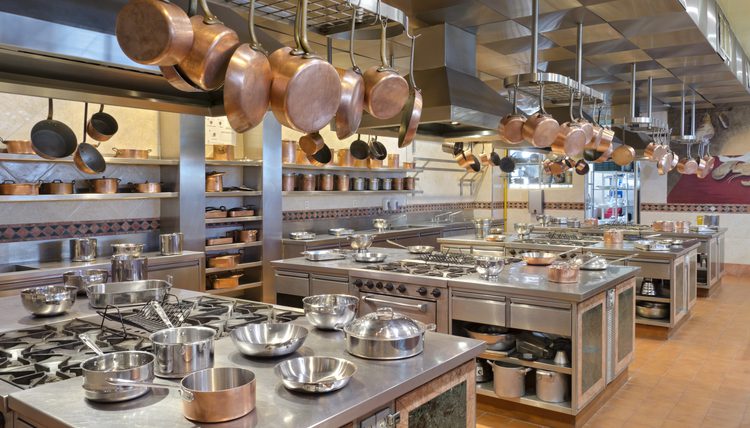What is a qualified commercial kitchen?
Commercial kitchens are similar to restaurants, factories, colleges, institutions, organs, troops, hospitals, enterprises, train, ship canteens (dining halls) and other types of kitchens. This type of kitchen is large-scale production, can provide a large number of customers to eat at the same time, by different functions of the work area or small Combined kitchen. Each work area or small kitchen division of labor clear, coordinated, undertake the above enterprise or hotel large-scale production work.
Commercial kitchens are much larger than home kitchens, and there are big differences in equipment. We need to clarify its characteristics, types, and methods of setup, and then design according to its own needs.
What are the characteristics of the commercial kitchen?
(1) Efficient strain capacity
Has the extremely fast contingency ability, the customer orders at will must be on the table in a short time. This needs each kind of work fast silently coordinates the equipment to be handy.
(2) To meet the technical reserves and material reserves
General kitchen has made a variety of dishes, snacks, rice, etc. the main non-staple food, have fried food and other processing equipment. According to business needs, must have certain material reserves and technical reserves, in order to adapt to the needs of customers, to maintain market competitiveness.
(3) Unique skills and equipment needs.
Different kitchens have their own unique business orientation and service items. They have their own unique processing technology, processes, and cooking temperature. The kitchen and kitchen equipment they need to have their own unique intentions. For example, hotpot shops and barbecue shops move cooked kitchen equipment to the dining table, so the kitchen needs less equipment. Main cuisines, specialties, and special dishes require special kitchen equipment.
(4) Keep up with the needs of the market
From purchasing to the final meal, the kitchen should operate according to the needs of the market. From the first customer to the last customer to go out, the kitchen should be ready to respond, with a comprehensive operation according to customer needs.
(5) Labor-intensive places
A kitchen is a labor-intensive place. Although much-advanced technology and equipment enter the kitchen, a large number of main and non-staple food can only be produced according to the number of customers randomly needed, variety and taste, by the chef hand-made.
(6) Pulse work rhythm
A kitchen is a place where people, things and information flow quickly. During the peak period of dining, a dish has to go through many processes, and it is processed and transmitted by many employees. The dishes are delivered to the customers' table in a short time. The work is extremely tense and busy.
(7) Heavily polluted workplaces
A commercial kitchen is a workplace with serious environmental pollution. While making delicious food, it produces a large amount of lampblack, exhaust gas, noise, waste heat, sewage and garbage in It is also called processing center in some big hotels at home and abroad. It is responsible for the processing of cooking materials needed by cooking kitchens in hotels. Because of the large daily workload of processing kitchens, more goods in and out, and more garbage and water consumption, many restaurants have set up their kitchens in Low-Rise access to convenient, easy to discharge sewage and more concealed places.
a limited working space. A kitchen is a place where food is produced. It needs a high degree of cleanliness and hygiene. However, the kitchen has become a chase for mosquitoes, cockroaches, and mice because of the large amount of delicious food, scrap waste, and sewage.
(8) High consumption places
The kitchen consumes a large amount of water, electricity, and fuel every day, which is the place with the highest energy consumption and operation cost of the hotel. It is also the place that needs to be studied carefully to reduce energy consumption.
(9) Crowded and narrow
The kitchen of most restaurants is out of proportion to the use area of the dining room, the kitchen is poorly located and relatively crowded and narrow. From the analysis of the above kitchen work characteristics, we can see that the kitchen is a very special system engineering with more professional categories, different kitchens have different prominent characteristics, the planning and design have different emphasis, but Rarely identical. An American management scientist once said that apart from the similar kitchen designs of chain stores, it is impossible to find two kitchens in the world that are identical in design and layout. Different kitchen structures, different types and grades, different specialty cuisines, different work experience, and different managers all have differences. Requirements, kitchen planning, and design to integrate a variety of necessary conditions, comprehensive consideration of the device, repeated manipulation, seeking the best solution, will never be like residential, can be replicated in batches, a multi-purpose map.
How to set up a commercial kitchen?
1.Food List
Prepare a detailed list or menu of all foods you plan to prepare in the commercial kitchen. Describe in detail the method of food storage and preparation. This is one of the most important steps in planning a commercial kitchen and should be done prior to choosing space or equipment. Include all menu items you may wish to add in the future. (A small commercial kitchen approved as a bakery or sandwich shop may not meet health code requirements if you later wish to add soups, salads, deep-fried items or pizza.) Careful planning will avoid costly changes in equipment or construction.
2.Equipment List
Make a complete list (including detailed measurements) of all equipment you will require for food preparation, refrigeration, display, and storage. Every single item of equipment must meet commercial health code requirements. Determine if you will require a walk-in refrigeration unit or free-standing cold storage equipment. The size and amount of equipment, plus food preparation counter surface, will dictate the amount of space needed in your commercial kitchen.
3. Choose a Location
Select a site location for your small commercial kitchen. Determine if you will construct a new building or remodel an existing commercial space. Contact your local zoning commission to determine if your new business venture complies with zoning restrictions.
4.Plan Your Space
Take exact measurements of the size of the space if you are remodeling an existing building. Make note of existing windows, doorways, electrical outlets, plumbing lines, and floor drains. Make a sketch of the existing space, making note of the present flooring material, wall and ceiling surface and all heating, exhaust or air-conditioning vents. For a new building, draw out a rough sketch of the dimensions and special features of proposed construction.
5. Plan how you will use the space in your commercial kitchen
Ergonomics is the number one consideration in the design of kitchen space. Commercial kitchens should be designed for maximum labor efficiency, safety, and functionality. Make sure that there is plenty of room to move about freely when carrying hot pots and bulky supplies. If employees do not have to waste time and extra movement completing a task, efficiency is increased and fatigue and workplace injuries are reduced.
6.Local Codes
Contact your local city or state building inspector and make an appointment to review your preliminary plans. Health and fire codes must be met. Space may need to be remodeled to satisfy requirements. Regulations govern how far a food preparation area must be away from any sinks or waste and disposal drains, the installation of vents and grease traps, the size and temperature capacity of hot water tanks and the design and location of food storage areas. Make sure you receive a printed copy of all rules and regulations prior to designing the commercial kitchen space. Regulations vary from state to state, dependent on location, the size of the kitchen and the number of patrons you are allowed to seat in the premises. City or county ordinances may apply.
7.Professional Blueprints
Employ the services of a professional architect or building contractor to design the commercial kitchen, incorporating all building and health department rules that apply. Prior to purchasing equipment or commencing construction or remodeling, the detailed drawings or blueprints must be reviewed and officially approved by both the health department and fire inspector. Blueprints must include electrical wiring schematics, fire suppression equipment installation drawings, emergency, and handicap access routes, plumbing and electrical installation plans and a complete list of all building materials.
Search
Categories
Popular Posts



















Comments: 0
No comments